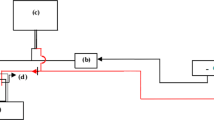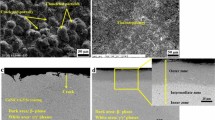Abstract
Interconnects of PCFC and SOFC are exposed to dual atmosphere conditions; fuel (e.g. H2) on the anode side and air on the cathode side. Sandvik Sanergy HT has been investigated under simulated fuel cell conditions at high temperatures. The microstructure and composition of the oxide scales formed at the cathode side (air) were significantly influenced by dual atmosphere conditions. The main effect was a substantial increase of Fe in the oxide scales by the formation of Fe rich nodules accompanied by localized metal loss. The size and number of the nodules increased when introducing water vapour on the air side of the samples. It is suggested that the preferred localization of nodule formation is given by the surface finish as a result of fabrication (e.g. grooves and scratches). By increasing the reaction temperature or duration of the exposures, the effect of dual atmosphere conditions became less pronounced. Alterations to the oxidation mechanism as a consequence of dual atmosphere environments are discussed with basis in the effect of hydrogen permeation through the interconnect alloy. Samples PVD coated with a double layer of metallic Ce and Co were also tested under single and dual atmosphere conditions. No significant change was found in the oxidation behaviour by dual atmosphere exposures.









Similar content being viewed by others
References
J. W. Fergus, Materials Science and Engineering A 397, 271 (2005).
Y. Zhenguo, M. S. Walker, P. Singh, J. W. Stevenson and T. Norby, Journal of the Electrochemical Society 151, B669 (2004).
Z. Yang, G. Xia, P. Singh and J. W. Stevenson, Solid State Ionics 176, 1495 (2005).
Z. Yang, G.-G. Xia, M. S. Walker, C.-M. Wang, J. W. Stevenson and P. Singh, International Journal of Hydrogen Energy 32, 3770 (2007).
G. Holcomb, M. Ziomek-Moroz, S. Cramer, B. Covino and S. Bullard, Journal of Materials Engineering and Performance 15, 404 (2006).
J. Rufner, P. Gannon, P. White, M. Deibert, S. Teintze, R. Smith and H. Chen, International Journal of Hydrogen Energy 33, 1392 (2008).
S. K. Yen and Y. C. Tsai, Journal of the Electrochemical Society 143, 2736 (1996).
J. W. Fergus, Y. Zhao, R. Haney, K. Cramer and L. Riherd, ECS Transactions 25, 101 (2010).
P. Kofstad, Oxidation of Metals 44, 3 (1995).
B. Tveten, G. Hultquist and T. Norby, Oxidation of Metals 51, 221 (1999).
K. Nakagawa, Y. Matsunaga and T. Yanagisawa, Materials at High Temperatures 20, 67 (2003).
H. Kurokawa, Y. Oyama, K. Kawamura and T. Maruyama, Proceedings of the Electrochemical Society 16, 170 (2003).
A. W. Bredvei Skilbred and R. Haugsrud, International Journal of Hydrogen Energy 37, 8095 (2012).
P. E. Gannon and P. T. White, ECS Transactions 16, 53 (2009).
J. Froitzheim and J. E. Svensson, ECS Transactions 35, 2503 (2011).
J. Froitzheim and J. E. Svensson, Materials Science Forum 696, 412 (2011).
H. T. Sanergy, Material Data Sheet, Sandvik Materials Technology (2009).
M. Ziomek-Moroz, B. D. Covino, Jr., S. D. Cramer, G. R. Holcomb, S. J. Bullard, P. Singh, C. F. Windisch, Jr., in 29th International Technical Conference on Coal Utilization & Fuel Systems; Coal Technology Association. 2004, 2, 1121.
K. Huang, P. Y. Hou and J. B. Goodenough, Solid State Ionics 129, 237 (2000).
A. W. B. Skilbred and R. Haugsrud, Journal of Power Sources 206, 70 (2012).
T. Brylewski, J. Dąbek and K. Przybylski, Journal of Thermal Analysis and Calorimetry 77, 207 (2004).
A. M. Huntz, A. Reckmann, C. Haut, C. Sévérac, M. Herbst, F. C. T. Resende and A. C. S. Sabioni, Materials Science and Engineering A 447, 266 (2007).
T. Horita, H. Kishimoto, K. Yamaji, Y. Xiong, N. Sakai, M. E. Brito and H. Yokokawa, Journal of Power Sources 176, 54 (2008).
H. Kurokawa, K. Kawamura and T. Maruyama, Solid State Ionics 168, 13 (2004).
S. J. Geng, J. H. Zhu and Z. G. Lu, Electrochemical and Solid-State Letters 9, A211 (2006).
A. C. S. Sabioni, A.-M. Huntz, E. C. da Luz, M. Mantel, and C. Haut, Materials Research 6 (2003).
S. K. Yen and Y. C. Taai, Jounal of the Electrochemical Society 143, 2736 (1996).
A. Yamauchi, Y. Yamauchi, Y. Hirohata, T. Hino and K. Kurokawa, Materials Science Forum 522–523, 163 (2006).
P. Kofstad, High Temperature Corrosion, 1st edn. (Elsevier Applied Science, 1988).
H. Asteman, J. E. Svensson, M. Norell and L. G. Johansson, Oxidation of Metals 54, 11 (2000).
E. Essuman, G. H. Meier, J. Zurek, M. Haensel and W. J. Quadakkers, Oxidation of Metals 69, 143 (2008).
E. Essuman, G. H. Meier, J. Zurek, M. Haensel, L. Singheiser and W. J. Quadakkers, Mater. Sci. Forum 595–598, 699 (2008).
S. Fontana, S. Chevalier and G. Caboche, Journal of Power Sources 193, 136 (2009).
T. Norby, Journal of Physics IV 3, 99 (1993).
R. E. Lobnig, H. P. Schmidt, K. Hennesen and H. J. Grabke, Oxidation of Metals 37, 81 (1992).
J. Gilewicz-Wolter, J. Dudała, Z. Żurek, M. Homa, J. Lis and M. Wolter, Journal of Phase Equilibria and Diffusion 26, 561 (2005).
A. Huntz, Journal of Materials Science Letters 13, 821 (1994).
C. Piehl, Z. Tokei and H. J. Grabke, Materials Science Forum 369–372, 319 (2001).
H. J. Grabke, E. M. Muller-Lorenz, S. Strauss, E. Pippel and J. Woltersdorf, Oxidation of Metals 50, 241 (1998).
G. H. Meier, W. C. Coons and R. A. Perkins, Oxidation of Metals 17, 235 (1982).
S. Leistikow, I. Wolf and H. J. Grabke, Werkst. Korros. 38, 556 (1987).
R. L. Higginson and G. Green, Corrosion Science 53, 1690 (2011).
J. Zurek, G. H. Meier, E. Essuman, M. Hänsel, L. Singheiser and W. J. Quadakkers, Journal of Alloys and Compounds 467, 450 (2009).
P. Huczkowski, V. Shemet, J. Piron-Abellan, L. Singheiser, W. J. Quadakkers and N. Christiansen, Materials and Corrosion 55, 825 (2004).
W. J. Quadakkers, P. Huczkowski, D. Naumenko, J. Zurek, G. H. Meier, L. Niewolak and L. Singheiser, Materials Science Forum 595–598, 1111 (2008).
R. Guillamet, M. Lenglet, L. Gazin, B. Hannoyer and J. Lopitaux, Surface and Interface Analysis 20, 15 (1993).
H. E. Evans, A. T. Donaldson and T. C. Gilmour, Oxidation of Metals 52, 379 (1999).
Acknowledgments
Sandvik Materials Technology is acknowledged for providing samples. This work is supported by the RENERGI project 185322 “Stack Technology for Ceramic Proton Conductors (StackPro)” of the Research Council of Norway.
Author information
Authors and Affiliations
Corresponding author
Rights and permissions
About this article
Cite this article
Skilbred, A.W.B., Haugsrud, R. The Effect of Water Vapour on the Corrosion of Sandvik Sanergy HT Under Dual Atmosphere Conditions. Oxid Met 79, 639–654 (2013). https://doi.org/10.1007/s11085-012-9313-7
Received:
Revised:
Published:
Issue Date:
DOI: https://doi.org/10.1007/s11085-012-9313-7




